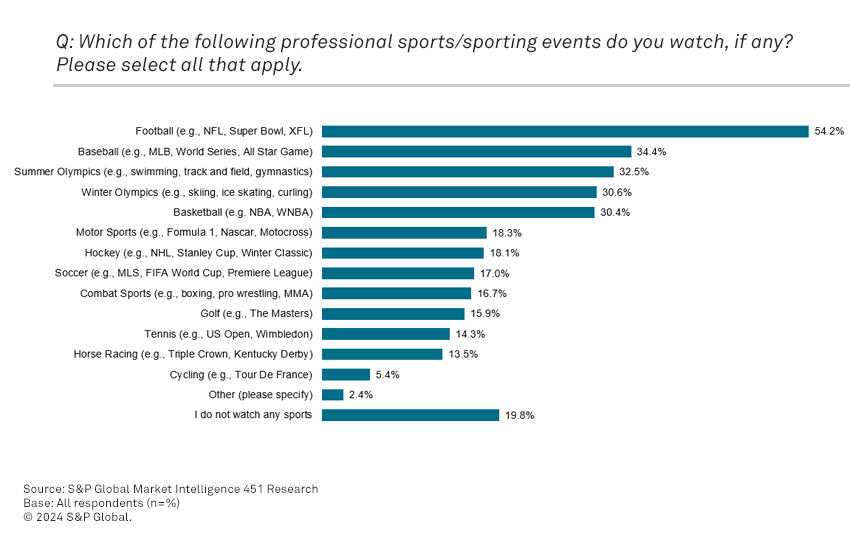
United States sports fans make up an estimated 80% of the country’s population, according to our Connected Customer, Fintech & Holiday Experience 2023 survey. It is one of the largest shared demographics within the nation. Fifty years ago, sports fans had three ways they could experience events: watching in person, watching on television or listening to the radio. After half a century of technological advances, it is easier than ever for sports enthusiasts to keep up with their favorite games — via streaming, podcasts, social media and more — but where does the fan experience go from here? With the introduction of more powerful artificial intelligence, some tech vendors are exploring answers to that question.
The Take
The next phase of sports media will likely be built on rising interactivity, allowing fans who are watching from their homes to be as close to their games as possible remotely and making that experience something in which they can find greater value. While there are surely some who prefer to watch things in as simple a form as possible, there are others (likely the extremely dedicated fans) who prefer deeper insight and extra features to help maximize their viewing experience. Advanced analytics, data visualization, rendering tools and many other technologies are already changing the game in sports. With tools such as artificial intelligence receiving considerable buzz in recent months, the aforementioned previous advances could get an even larger boost and enrich the digital experience for sports fans.
A sample of sports viewership across the US
Sports culture across the world is vast. However, the US in particular is a major force. From the large states to the small towns, sports fans can be found anywhere. US athletes generally begin their sport in childhood, with the most successful receiving large scholarships to universities, sponsorship opportunities to play in college leagues and more. The pipeline of child prodigy to professional athlete is not uncommon in the US. As a country, it has produced the most Olympic medalists, ahead of the other top four competing countries (the United Kingdom, Germany, France and Italy) combined. Of the general public, 80% of US respondents watch sports, ranging from football and baseball to more niche offerings such as horse racing or cycling.
The top three sports that people watch in the US are American football (54%), baseball (34%) and the Summer Olympics (34%), according to our 2023 Fintech and Holiday Experience survey. The fourth was the Winter Olympics (31%) and the fifth was basketball, at 30%. Other more niche sports included combat sports (e.g., boxing, mixed martial arts — 17%) and cycling (e.g., Tour De France — 5%). While the largest group of sports-viewer respondents across the board watched only between one and four hours of sports content during a given week, regardless of the specific sport, there are some (although a much smaller subset of people) who state that they watch content for over 12 hours in the same period of time.

We estimate that an average of 45% of sports viewers watch between one and four hours of media per week across all different leagues and events, although some, such as motor sports (e.g., NASCAR or Formula 1), have a larger percentage (53%) of people watching for shorter intervals overall than others such as football (40%). Football also had one of the largest sport-specific groups of respondents who watched the longest, with about 13% saying they did so. Given that it was also the most popular sport in the US according to our survey, this is not surprising.
When asked how they have engaged with their favorite sports teams/kept up with sports in general, the majority of respondents (74%) stated they do so via television, streaming services, etc. Relative ease of access is apparent, and it is likely that this viewership is taking place somewhat locally (i.e., in the home, at a local sports bar, a friend’s house or similar). There is an immediate drop of over 50% to the second-most-popular option, which was listening to sports radio or sports podcasts. It should be noted that streaming has become more fragmented and requires multiple paid subscriptions in many cases, and thus may create barriers in the case of some viewers. A little over one-quarter of the population (28%) consumes sports media in this way. The third-highest option, at 24%, was attending a game or match in person.
How changing technology has ushered in generations of sports fans and where it goes from here
Fifty years ago, sports viewing was limited to three main methods: watching a game in person, watching it on television or listening to it on the radio. While all three are still in use today, the breadth of channels on which sports content can be consumed is now vast. There are countless sports pages on social media, an array of different podcasts, endless fantasy draft leagues and much more. Any combination of those can fit an individual’s level of interest in the pastime, which has not only allowed for the creation of more fans overall, but also fans who feel that there is an experience that coordinates with their own specific habits.
Digital media has made access to nearly every point of the modern sports experience possible in what seems like an instant. Because sports fans make up such a large group, it is likely they will not get bored soon, but that does not mean that the networks, teams and leagues, that power it should take such constant viewership for granted. The next phase of sports media will likely be built on rising interactivity, allowing fans who are watching from their homes to get as close to their games as possible and making that experience something in which they can find greater value. User-level data is already making much of this a reality, but 2023’s boom in generative AI could leverage that data further to change real-time sports viewing.
Top uses of generative artificial intelligence and how they can apply to the fan experience
When generative AI had a boom at the start of 2023, it presented the world with new opportunities to learn, to work and to advance. Although there are concerns among the general populace about the technology, and society remains generally divided as to its ethics, there are real-world use cases where consumers see value. About half (51%) of the population either has used generative AI tools or plans to use them, with the biggest purposes being for general information search (45%), writing assistance (36%) and customer support (31%). Although the latter two likely have little to do with the sports experience, the top choice being general information search provides insight into what consumers are looking for: knowledge.
Serious sports fans differ from casual viewers often due to a depth of understanding, and bringing some form of deeper informative capabilities to a broadcast in whatever medium, would likely go far in boosting engagement overall. In the case of fragmented viewing from streaming complexities, this is also where artificial intelligence can be deployed for discoverability. It is able to inform users about what is happening with their favorite teams and players, and to enhance the content they are consuming. Some examples of this include what Amazon.com Inc.’s Prime Video has delivered through NFL Thursday Night, YouTube TV’s NFL Sunday Ticket and Apple Inc.’s integrations with MLB and MLS. This has caused legacy media companies to add direct-to-consumer sports tiers and packages, such as ESPN+, Max, Paramount+ and Peacock, in order to remain competitive.
On the enterprise side, new opportunities arise where the sports industry’s own recent advances in analytics and data visualization will likely hold considerable merit for the next generation of artificial intelligence. According to our 2023 Customer Experience & Commerce, Vendor Selection survey, the top generative AI use case for businesses was data management and analyzing relationships between different variables in a dataset and identifying patterns, with 37% of respondents stating so. In terms of broadcast overlays through real-time data outputs, the potential for sports brands to elevate their own experiences using the technology is massive. It can also be used for more advanced renderings for smaller elements like creative visuals, which goes a long way in making a difference in a viewing session through more precise details.
Examples of AI being deployed by vendors in sports
- Salesforce Inc. and Formula 1: While motorsports were not the most popular among US consumers, Formula 1 is one of the most-watched events worldwide. Estimates often place it in the top five, alongside the FIFA World Cup, Wimbledon and the Super Bowl. This year, Formula 1 partnered with Salesforce to process its data using artificial intelligence through Customer 360 to personalize the viewing experience at the individual level in real time. According to both companies, one-third of current Formula 1 fans are new, which they attribute to a deeper level of technological involvement, including viewers using multiple devices to keep track of the races as they happen. Customer 360 is powering the platform based on cloud data collected at various touchpoints across the F1 journey and using AI to tailor it to the individual viewer.
- Adobe Inc. and MLB: Adobe is no stranger to working with sports leagues through its Experience Cloud. In the case of its work with MLB, the two partnered to redesign the fan experience for a more digital age by implementing Experience Platform applications within all 30 different ball clubs for more advanced relationship building. Adobe Experience Cloud is powered by Sensei, its artificial intelligence and machine-learning model, which it uses to process data for deeper learning and real-time decision-making. Features that resulted from the partnership include personalized notifications relevant to the specific individual, including at ballparks, which relayed information such as the closest entrances to the guest’s seats, parking promotions or discounts on concessions, and more based on real-time customer profiles.
- Genius Sports Ltd. and the NFL: With football the most-watched sport in the US, it too needs a next-generation viewing experience to attract fans. Genius Sports is a London-based publicly traded company founded in 2015 that develops AI-backed data tools specifically for the sports industry. The company is partnered with the NFL as the organization’s exclusive distributor of league data, which has allowed it access to NFL+, the NFL’s own dedicated streaming service. Genius Sports is providing NFL+ viewers two customized viewing modes for every game of the 2023-2024 season available through the service. These modes leverage player statistics from the NFL and display it to fans in real time, with tracked metrics including ball-carrier speed, yards after catch and time to throw. The overall goal is to provide fans with deeper insight into the games they are viewing in order to boost engagement.
Want insights on consumer tech trends delivered to your inbox? Join the 451 Alliance.

